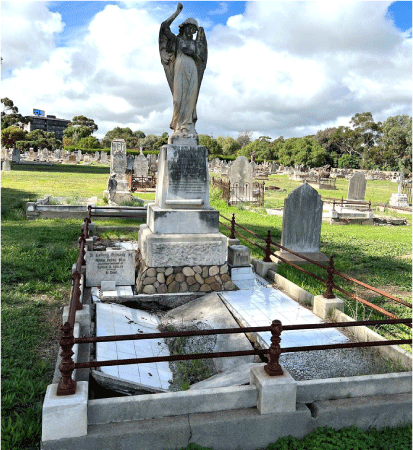Oswald Bertram Lower (1864–1925): a South Australian pioneer in the discovery of Australia’s biodiversity
Peter B. McQuillan A * , Ted Edwards B and Jenny Camilleri C
A * , Ted Edwards B and Jenny Camilleri C
A School of Geography & Environmental Studies, University of Tasmania, Hobart, Tas. 7001, Australia.
B 56 Lachlan Street, Macquarie, ACT 2614, Australia.
C Broken Hill Family History Group Inc., Broken Hill, NSW 2880, Australia.
Abstract
An Adelaide-born pharmacist, Oswald B. Lower, is a neglected figure in the pantheon of early Australian amateur entomologists. Specialising in Lepidoptera, he worked mainly around Adelaide and Broken Hill where he discovered hundreds of new species, especially in the semi-arid zone of southern Australia. Lower named almost 1000 valid new species between 1892 and 1923 based upon his own material and specimens sourced from contacts in other parts of Australia. His legacy of 40 000 specimens, assembled between the 1880s and early 1920s, forms the nucleus of the outstanding Lepidoptera collection at the South Australian Museum. Many are sourced from locations now lost or degraded and the collection will be an invaluable tool in the emerging challenge of habitat restoration in Australia.
Keywords: butterflies, collections, entomology, environment, mallee, moths, museum, natural history.
Introduction
In the discovery and description of Australia’s remarkable invertebrate fauna, the pre-eminence of overseas entomologists associated with the great museums of the imperial powers was gradually eclipsed by the rise of local researchers in the late Victorian era.1 Through a combination of local fieldwork, publication in accessible journals and diligent networking and collection-building, their endeavours established an important foundation for today’s modern Australian systematics.2
Adelaide-born Oswald Bertram Lower (1864–1925) (Fig. 1) was one such pioneer in the documentation of South Australia’s biodiversity but is among the least known local entomologists of the late nineteenth–early twentieth centuries. He merits but a single sentence in Froggatt’s 1907 summary of insect collections and collectors.3 He has no entry in the Australian Dictionary of Biography and rates only three short lines in Musgrave’s Bibliography of Australian Entomology,4 sourced from the president’s brief eulogy of recently deceased members of the Linnean Society of New South Wales.5 Stan Edmunds name-checks Lower in his review of the contribution of zoologists to the progress of natural sciences in South Australia but offers little detail.6
Oswald Bertram Lower aged about 35 years at his home in Wayville. Photograph courtesy of South Australian Museum.
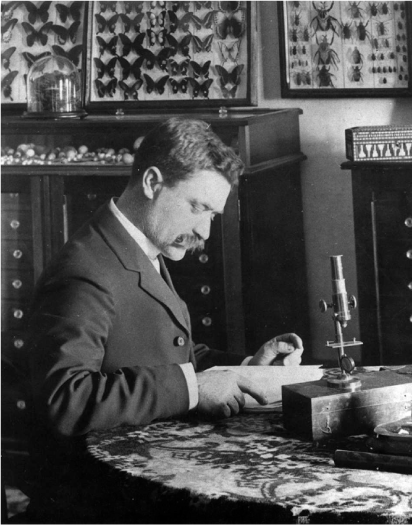
Lower was a contemporary of several other significant figures in South Australian entomology, including the coleopterists Thomas Blackburn (1844–1912) and Arthur M. Lea (1868–1932), both of whom have been the subject of comprehensive obituaries.7 Yet over a period of four decades, Lower published forty-five solo publications on Lepidoptera (plus two co-authored with Edward Meyrick (1854–1938)),8 and described and formally named almost one thousand new species of Lepidoptera (moths and butterflies), mostly from southern Australia but also from Queensland and the Northern Territory.
In this article we redress this neglect by recounting Lower’s life and times in entomology and reflect on the scientific legacy of his remarkable body of work. In the absence of significant primary documentation, we have largely relied upon secondary sources such as contemporary newspaper reports. Nevertheless, our understanding of Lower’s professional relationships with other workers is also based upon surviving correspondence and other documents.
Early life
One of seven children, Oswald Bertram Lower was born on 28 February 1864 at Norwood, an inner eastern suburb of Adelaide. He was the third son of Samuel Lower (1835–84) who arrived from Seaford, Sussex in March 1854, a baker/musician/warehouseman. Samuel’s future wife, Susannah (or Suzannah) Simmons (1838–1911) arrived from Cornwall about 1849, and married Lower in 1855 in Adelaide. The family lived in Clarke Street, Norwood until late in 1869 when they moved to Angas Street in the city. The records of nearby St Paul’s Anglican Church record that Oswald and three siblings were baptized in August 1874 and his father’s occupation is listed as an accountant. Sadly, the family was disrupted by the alcoholism of this father who tragically suicided in 1884 at the age of 49.9
Details of Lower’s early schooling remain obscure, but he is believed to have attended Prince Alfred College at some stage.10 He trained under Dr Charles H. Gosse MD (1849–85), an eminent Adelaide physician, and by 1884 Lower was a practising pharmaceutical chemist in Unley Road, Parkside. Remarkably, five of Samuel and Susannah’s six sons became pharmacists in South Australia.
Lower’s early interests in natural history were broad and he is recorded in the local press as exhibiting ‘pleasing and attractive’ watercolours of native flowers in 1885—evidence of a close observer of nature on its own terms.11 But his professional calling was elsewhere. By the age of 20 he was earning a living as a chemist and his entrepreneurial tendencies are evident in a long letter published in the South Australian Advertiser comprehensively advising the local tramway company how to improve its service and viability.12
Family life
Details of his family life are scant, but Lower was apparently close to his mother and siblings. He was 45 years of age and a successful businessman when he married Eva Davies, a young music teacher and the eldest of four sisters (born 1887 in Silverton, New South Wales, died 1952) in South Broken Hill on 20 March 1909.13 They had two sons, Oswald Bertram born in Broken Hill in 1914, and Raymond born at Wayville in suburban Adelaide in 1918. A memorial notice on the first anniversary of Lower’s death suggests a loving home life and a young family bereft on his passing.14
Inevitably perhaps, most of Lower’s siblings were recruited as sometime collectors and natural history observers. In an early publication on South Australian butterflies, he notes: ‘in the present paper I am able to bring the total up to 40 species, chiefly through the diligent collecting of my two brothers Messrs. Harold and Rupert Lower … taken within a radius of 30 miles of Adelaide’.15 Various female members of Lower’s immediate family are recalled in the names of several of his new species, although some of these epithets have been relegated to synonymy. In appreciation of his wife’s ‘keen interest in the Hesperiadae … of valued assistance to me’,16 he dedicated a new species of skipper butterfly to her, recalling her full name, Eva Linda May, in the euphonious Hesperilla malindeva Lower (Fig. 2). Two small moths from Broken Hill honour his mother. The description of Nephogenes susanae Lower (now in Philobota) is annotated: ‘I have dedicated this pretty and interesting little species to my mother … in grateful recognition of her unvarying kindness in attending to my large collection during my sojourning in the pursuit of entomology’;17 but the common mallee crambid Scoparia susanae Lower was described without comment.
Hesperilla malindeva Lower, 1911—a skipper butterfly that Lower named after his wife Eva, from specimens collected by F. P. Dodd at Herberton, north Queensland in 1910. Photograph courtesy of CSIRO/BIO Photography Group.
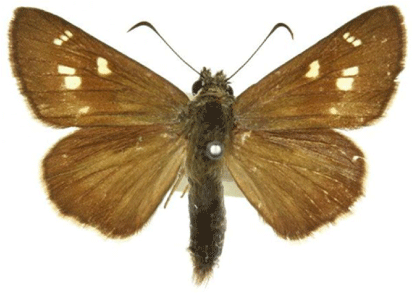
The attractive cosmopterigid moth Limnoecia ida Lower was ‘bred by my sister (to whom I have dedicated it) from larva feeding in seed-heads of Juncus sp.’ at Henley Beach.18 Another ‘remarkably distinct and beautiful species’, the oecophorid Philobota idae Lower, was ‘taken at Blackwood by my sister, to whom I have dedicated it’,19 but is now regarded as a synonym of Tanyzancla acutella (Walker). An obituary of Ida records that: ‘The Lower entomological collection in the Museum owes its preservation to her care and attention during the long residence of her late brother, Mr. Oswald B. Lower, at Broken Hill.’20
In relation to the Pittosporum-feeding moth Tortrix eveleena Lower (now in the genus Epiphyas), Lower comments that: ‘My brother (Mr Harold Lower) who discovered the species, tells me that he never met with it on the wing. I have dedicated this pretty species to my sister-in-law (Mrs. Eveleen Lower), in recognition of her keen interest in entomology’.21 Harold also collected moths at Semaphore,22 and nearby Exeter, discovering Agrotis gypsina Lower (now in Proteuxoa) on the Adelaide coastline.23 It was also Harold who discovered the ‘distinct and beautiful … rosy carmine’ Sterrha rhodocosma Lower (now in Notiosterrha, Fig. 3) at Torrens Island and Semaphore, where it was ‘beaten from Salicornia arbuscula’—the shrubby glasswort, now in Tecticornia.24
Notiosterrha rhodocosma (Lower, 1897) from the O. B. Lower Collection. Now extinct at Semaphore, it’s type locality. Photograph courtesy of South Australian Museum.
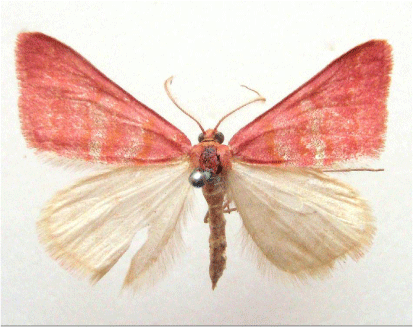
Brother Rupert, who spent a few years in Broken Hill with Lower at the turn of the century (1899–1901), later moved to newly settled Pinnaroo, South Australia in the Murray Mallee where he operated a pharmacy (from about 1906 until 1915) and was an important source of novel specimens from the semi-arid zone.25
Although Lower’s eldest son, the eponymous Oswald Bertram joined the medical profession, neither he nor his brother, Raymond, followed in their father’s entomological footsteps. However, a great nephew, Harry F. Lower, was appointed as the systematic entomologist and curator of the Waite Agricultural Research Institute insect collection in 1950, and held the position until the early 1960s.26 A talented insect morphologist, Harry’s interests centred on acalyptrate flies and cicadellid bugs.
Adult life in Broken Hill and Adelaide
The 24 year-old Lower and his newly married younger brother Sydney Waldmere (1866–1930) came to Broken Hill in 1888, the same year the narrow gauge railway from Adelaide was completed (Fig. 4). Here they established a successful business, the Barrier Ranges Apothecaries, in the rapidly growing frontier mining town.27 Their enterprise, dispensing a range of proprietary potions as well as cordials, was in Argent Street until 1891 when they relocated in the same street to the newly built Pirie building (283–295 Argent Street) opposite the Town Hall (Fig. 5).
Argent Street, Broken Hill looking north from Billy Goat Hill, about 1888, the year Oswald and his brother Syd arrived in the town. Photograph courtesy of Jane Beattie, University of Melbourne. Record ID: UMA/I/3999.
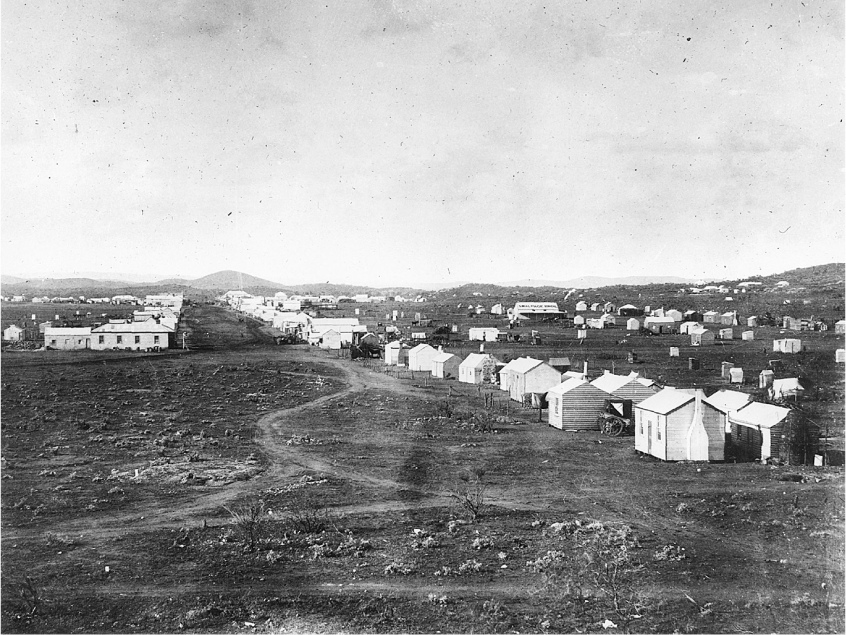
The Pirie Building in Argent Street, Broken Hill from which Lower operated his pharmacy business 1891–1925. Photograph courtesy of Denis Binnion.
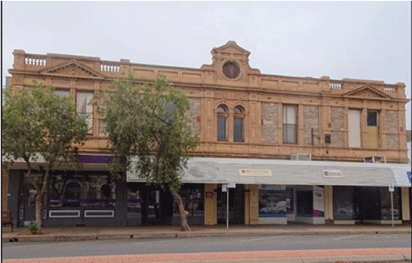
The family were well known for products such as Lower’s Corn Cure and Lower’s Menthogene used for toothaches. Sydney operated the optical department and dispensary while Lower prepared the medicines. An 1895 advertisement in the local Barrier Miner extols ‘homoeopathic medicines prepared fresh daily by Mr. Oswald Lower, F.L.S., F.E.S., who has had 20 years’ practical experience in homoeopathy’.28 The hot, dusty and lonely environment was rich in opportunities for medical entrepreneurs, and local pharmacists dispensed compounds across a wide spectrum, from simple lotions for common ailments such as sandy blight to the addictive chlorodyne, a powerful and addictive narcotic sedative. If administered with copious whisky (not recommended by the Lowers), this potion could be a terminal antidote to the privations of a miner’s life as Lower recounts in a coroner’s enquiry in 1915.29 Syd was also a consulting chemist and advertised himself in 1895 as ‘the only lead poison specialist in Australia; five years practical experience in Broken Hill’ and offered a concoction, Lower’s Antidote, to those suffering the effects of fumes, lead and arsenical poisoning.30
By 1890, the brothers were living in Williams Street, which was once a creek bed. Both enjoyed sport: Lower was a vice president of the Oxide Cricket Club and Syd played football for Souths until he ‘got such a shaking up last Saturday that he has given the game up’.31 Unfortunately, the hard drinking Syd proved an unreliable business partner and left Broken Hill about the turn of the century, eventually setting up a pharmacy in Wellington, New South Wales; he is better remembered as the father of Lennie Lower (1903–47), the famous comic novelist (Here’s Luck published in 1930) and celebrated newspaper columnist.32
Lower remained committed to the Broken Hill community and retained an interest in the pharmacy there at the time of his death;33 he was still working intermittently at the shop in Argent Street in 1924, the year before he died.
Lower was engaged in civic life being a prominent freemason and a past Master of Barrier Lodge No. 173.34 Possessed of a notable tenor voice, he was a life member and sometime president of the Broken Hill Quartette Club, a leading male choral society,35 and was a foundation member of the Barrier Field Naturalists Club (established 1920). He exhibited butterfly collections at Red Cross fundraisers at the time of the Great War and in a patriotic gesture he donated a bugle to the second expeditionary force training at Morphettville near Adelaide.36 He was also a member of various philatelic societies and reputedly owned one of the finest collections of stamps in Australia.37
In the early 1890s, Lower was living part of each year at Parkside, a newly fashionable inner suburb of Adelaide. Adjacent to the extensive Adelaide Parklands, a remnant Eucalyptus microcarpa—E. leucoxylon woodland,38 Parkside was a source of many of Lower’s specimens and is the original or type locality of a number of his new species.
After retiring from Broken Hill, the Lower family lived at 18 Bartley Crescent, Parkside. After a fortnight of unspecified illness,39 Lower died there on the morning of 18 March 1925 at the age of 61 years and was laid to rest in the nearby West Terrace cemetery (Fig. 6) not far from his familiar collecting grounds in the parklands and in the gentle company of moths he had discovered and named.
Lower’s life in entomology
Through correspondence and exchanges with a wide network that included fellow entomologists, collectors and family members, Lower was able to source a steady stream of specimens for study from many parts of Australia (Supplementary Appendix S1). Moths that Lower described from Hoyleton in the Mt Lofty Ranges were probably sourced from the local schoolteacher Edward Guest who was based there 1892–4,40 and with whom he is known to have exchanged specimens.41 Guest’s small but historically valuable collection of South Australian Lepidoptera is also preserved at the South Australian Museum.
However, it is not always clear from whom Lower obtained material for study, whether by purchase or exchange. In the preamble to his catalogue of the described Victorian moth fauna he acknowledges his:
indebtedness to Messrs. Geo. Lyell, jun., of Gisborne, a most enthusiastic and energetic correspondent; J. A. Kershaw, of Windsor; Frank Spry, of South Melbourne, and other friends, for their kindness. To the first two gentlemen I am especially indebted for their indefatigable promptitude in replying to queries, loan of specimens.42
But there are hints that Lower’s relations with other colleagues were not always so cordial. His robust defence of his first paper on South Australian butterflies against a somewhat condescending review by J. G. Otto Tepper (1841–1923), the South Australian museum’s resident entomologist, barely disguises a degree of contempt for his critic.43 We also know from other correspondence that Frederick P. Dodd (1861–1937), the north Queensland collector-dealer of whom Lower was a valued customer, was disappointed in his client’s rather modest acknowledgement of his (that is Dodd’s) work.44
Lower sometimes named new species after colleagues in appreciation of their efforts. The Rev. Thomas Blackburn, Anglican Rector of St Thomas’, Port Lincoln (1882–6), and later an honorary curator in entomology (1887–1912) at the South Australian Museum,45 is recalled in the ‘rare and beautiful’ hepialid moth Aenetus blackburnii (Fig. 7) described by Lower in 1892. This is also the first new species that Lower formally named.46 James Kershaw (1866–1946) is recalled in Caesyra kershawi Lower (now in the genus Heteroteucha) and George Lyell jun. (1866–1951) in two species: Glyphipterix lyelliana Lower (a synonym of Glyphipterix cyanochalca (Meyrick)) and Termessa lyelliana Lower (a synonym of Philenora undulosa (Walker)).
Aenetus blackburnii (Lower, 1892)—the first species of moth that Lower described, based on a specimen found by Rev. Thomas Blackburn at Port Lincoln, SA. [♀ Kangaroo Island SA, A. Young (CSIRO: ANIC)].
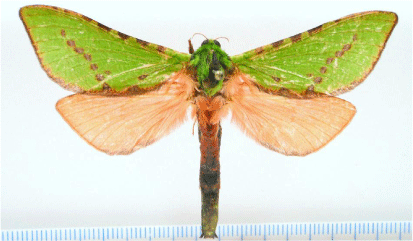
Although his first taxonomic paper describes species from a dozen locations in South Australia,47 Lower soon diversified the provenance of his specimens. By 1894 he was describing new moths from central Queensland sent by Mr George Barnard (1830–94), a frontier pastoralist living near Duaringa and Mr Rowland E. Turner of Mackay.48 The patriarch of a well-known family of amateur naturalists, Barnard also had connections to northern Tasmania and supplied Lower with specimens from the family properties Billopp and Windermere near Launceston. In the 1920s, Barnard’s daughter Mabel (Mrs F. H. Hobler) (1871–1925) also sent moths to Lower from the Warra district of south east Queensland.
Specimens from remote or newly explored localities were especially sought after by early entomologists, obtained from frontiersmen and women such as telegraph operators and expeditioners. Such prizes included Cryptophasa aglaodes (Lower) that Lower redescribed from a ‘male taken by Mr (Jim) Field at Tennant’s Creek, central South Australia’ via Sidney Angel (1876–1966) an Adelaide lepidopterist,49 and a species collected in 1893 by Mr Amandus Zeitz from distant Lake Callabonna, the site of a museum-sponsored paleontological expedition.
Lower was the first entomologist to study the exceptional moth fauna of the mallee woodlands, one of the most extensive natural biomes of southern Australia. His brother Rupert later lived at Pinnaroo, a small rural hamlet first settled around 1902, and sent numerous moths to Lower who described a significant number of new species from the eastern mallee, a habitat now known to be very rich in moth diversity (for example, Ngarkat Conservation Park).50 Another brother, Horace, discovered Eochrois sarcosma Lower (now allocated to the genus Pachybela) at Cockburn (attracted to light, probably at the station), the north-eastern terminus of the SA Railways.51 The naturalist David Goudie, a pioneer farmer at Birchip in the Victorian Wimmera, was a source of many Lower specimens and is recalled in the handsome pyralid Metallarcha goudii (now a synonym of M. beatalis (R. Felder & Rogenhofer)). The flamboyant oecophorid Polyeucta callimorpha Lower (Fig. 8) was described from a specimen collected near Cairns by the Queensland Museum collector Charles J. Wild (1853–1923) who worked along the new Cairns to Herberton railway for 16 months from 1890.52 Wild’s discoveries antedated the arrival of the better-known lepidopterist Frederick P. Dodd in nearby Kuranda in 1904.
Polyeucta callimorpha (Lower, 1894)—from north Queensland rainforest, one of the most spectacular members of the large moth family Oecophoridae. [♀ Kuranda Qld, viii.2003, D.C.F. Rentz (CSIRO: ANIC)].
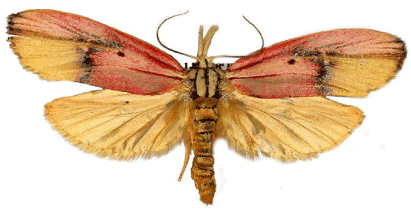
Lower received various honours during his lifetime, some duly recorded in the local press.53 He was elected a member of the Royal Society of South Australia in 1888 and the Linnean Society of New South Wales in 1891. He also received recognition from the United Kingdom (Fellow of the Entomological Society of London by 1892 and of the Zoological Society of London 1906) and Europe for his research.
Fittingly, Lower’s contribution to descriptive taxonomy is bracketed by two particularly aesthetic species. Thirty-one years after naming Blackburn’s splendid ghost moth, the last species he described is the beautiful gracillariid moth Parectopa clethrata Lower collected in the suburb of Wayville adjacent to his home, where he died after a short illness two years later.54 In a posthumous tribute to Lower, the Sydney-based lepidopterist Gilbert Goldfinch (1887–1943) proposed the genus Loweria for an attractive group of autumn-flying geometrid moths from Acacia woodland (mulga) habitats.55
His methods
In addition to his own fieldwork, Lower expanded his collection by exchanging specimens with other collectors and by purchase from natural history dealers. In the manner of the time, he steadily described batches of new species as they came to hand, publishing in the journals of mostly state-based scientific societies that flourished in the second half of the nineteenth century. He largely adopted the conventions of his scientific mentor Edward Meyrick FRS of Marlborough College, England, who was the leading lepidopterist in the British Empire.56 At that time, relationships among moth species, grouped into notional genera, were largely divined from subtle features observable with a hand lens, including wing shape and venation, the presence of scale tufts and other vestiture, aspects of the male antenna and the relative length of the palpi. An early colleague of Lower was Edward Guest, then teaching at Balhannah in the Mount Lofty Ranges, who had been a correspondent of Meyrick and submitted locally caught specimens to the latter in the 1880s.57 Meyrick visited South Australia on fieldwork in October 1882 and may have met Guest. Lower’s later papers were increasingly focussed on discussions of moth genera or families but his commitment to alpha taxonomy was lifelong.
In his taxonomic endeavours, Lower can be regarded a careful worker by the standards of his time and he described relatively few synonyms. This is all the more remarkable given his limited access to type specimens (the specimens on which new names were based) for comparison in the world’s major museum collections. In one clade of the taxonomically difficult family of oecophorid micromoths, Lower described 131 new species, of which 33 are currently considered as synonyms,58 while Selidosema zygophora Lower has recently been shown to be a synonym of a common New Zealand geometrid moth.59 He was criticised occasionally in print for carelessness with locality details,60 but his work was widely appreciated and the criticisms sometimes misplaced. For example, Gilbert Goldfinch writing in relation to the geometrid genus Paurocoma Lower, notes that ‘Turner’s [re]description … is not in agreement with Lower’s original description, which, though awkwardly expressed, is correct.’61 However, for the genus Amphicrossa Lower, Goldfinch observes that ‘[his] description of the forewing venation is not correct’, highlighting the limited efficacy of a hand lens for the task as much as a lack of skill by Lower.
Fieldwork was something that Lower enjoyed and annotations to some of his descriptions hint at his collection methods. These included: beating vegetation to dislodge resting specimens, collecting at lights at night, and rearing field-collected larvae to the adult moth stage; some examples include Nephogenes susanae (now in Philobota) ‘beaten from Bassia biflora’,62 Psoricoptera melanoptila Lower beaten from Solanum esuriale and Pseudopanthera habrocosma Lower (now in Lophothalaina) ‘beaten from Hakea rugosa, at Blackwood’. In aggregate, these notes provide a valuable insight into the broader biology of many species. Innovation in urban lighting was a fillip for nocturnal insect collecting. Argent Street in Broken Hill was illuminated by gas lights in 1889 and electricity arrived soon after, so Lower’s papers begin to record ‘specimens taken at electric light, or ‘at a street lamp’.63
The expansion of the rural rail network in late nineteenth century Australia was a boon to field naturalists of all persuasions, and unsurprisingly illuminated railway stations feature repeatedly in Lower’s accounts. Philobota ochrolitha Lower was discovered at ‘Duaringa … (opposite Railway Station)’ and the type localities Petersburg (now Peterborough) and Cockburn were important rail centres in South Australia, the latter connecting the South Australian rail network to Broken Hill via the private 56 km line of the Silverton Tramway Company.
By about 1900, Lower’s reputation was such that he could command the attention of world experts on difficult taxonomic matters, such as Sir George F. Hampson.64 Hampson (1860–1936), the world authority on the large cutworm family Noctuidae, described a number of new species from specimens submitted by Lower.65 And Lower’s 1911 paper on ‘Hesperiadae’ (as written) butterflies acknowledged guidance from leading British, German and Australian experts.66
Likewise, Lower encouraged his contemporaries, especially those who were early in their careers. Alfred Jefferis Turner (1861–1947), a Brisbane paediatrician who described several thousand moths mainly from Queensland and New South Wales, acknowledged in an early paper that ‘I must also express my indebtedness to Mr. Lower, of Adelaide, for advice and assistance’.67
O. B. Lower’s Lepidoptera collection
Lower’s interest in Lepidoptera probably dated from his teenage years. In documenting a swarm of interesting hawk moths in Broken Hill, he recalled that his brother Horace discovered the sphingid Deilephila livornica Esp. (now Hyles livornicoides (Lucas)] ‘in 1881, resting on a species of Lathyrus.’68 This is a famously irruptive inland species that reaches Adelaide and the southern coastline in some years.69
At the time he began publishing seriously on moths, Lower had already accumulated a significant collection. By 1892, he noted that for the micromoth family Oecophoridae alone, he had amassed ‘230 species in my own collection, collected within 20 miles of Adelaide’.70 In the same year he exhibited exotic butterflies at meetings of the Royal Society of South Australia.
Lower sold a large collection of foreign butterflies and moths (40 drawers) to the South Australian Museum in 1892. The balance of his extensive collection, assembled over many years, was purchased by the Museum in 1927, two years after his death.71 In the meantime, his collection had remained in the possession of his widow, but unfortunately it deteriorated to some degree during this period. Norman Tindale (1900–93), ethnographer and entomologist at the museum, recalled that his widow recounted how she ‘tidied up’ the collection,72 and many specimens, including some types, were probably lost in the process. Some items in the collection bear the tell-tale signs of museum beetle damage probably from this period.
In addition, specimens bearing Lower’s labels can be found in museum collections all over Australia and overseas; he donated and traded moths extensively with other leading collectors such as Edward Meyrick and Alfred J. Turner, both of whom described multiple new species from his material.73
Lower also purchased some specimens from natural history dealers. Turner notes that ‘Mr Lower had obtained to my knowledge many moths from Mr Dodd’,74 a well-known collector/dealer living in north Queensland.75 There was some minor debate about the provenance of some of Lower’s specimens, especially some annotated as from Queensland,76 but subsequent work shows that confidence can be had in the large majority of his labelled material.
Lower’s labels attached to specimens from Broken Hill and localities near Adelaide are generally distinctive—being pre-printed and annotated with an abbreviated date of collection added by hand (Fig. 9). A generic printed label reading ‘Australia, Lower Coll.’ was affixed to many pinned specimens at the time of their acquisition by the South Australian Museum.77 Specimens which Lower treated as the holotype usually had the word TYPE written on the label by hand (Fig. 9). Lower did not recognise paratypes (that is, additional specimens other than the holotype that were examined by the species’ author at the time of description and formally designated as such) but likely syntypes (specimens thought to be candidates to be formally designated as types by subsequent reviewers upon further study) can often be recognised among series of specimens in his collection.
Example of labels attached to a Lower specimen, in this case Thalaina tetraclada (Lower). The number 3459 relates to Lower’s hand written catalogue. Photograph courtesy of South Australian Museum.
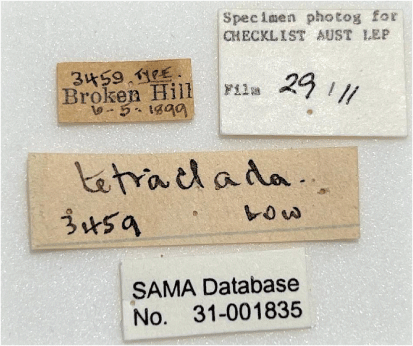
Lower also maintained a hand-written register (specimen catalogue) that recorded the codes he assigned to interesting specimens, including types. These codes are often prefixed with the letter L, followed by multiple digits—usually four.78 The register records the name of the species and some additional information such as locality, number of specimens and occasionally details of biology. Although usually accurate, the register is not comprehensive.79
Most of Lower’s moths were mounted on brass pins and therefore liable to develop verdigris which can damage the specimen, sometimes splitting the thorax and separating the wings. In the 1970s, many such degraded specimens were remounted on stainless steel pins by museum staff.80
Lower’s significance in science
In 1878, the visiting British lepidopterist Edward Meyrick presciently wrote: ‘I had only 3 months of actual collecting; but I venture to assert that in the matter of Micro-Lepidoptera Australia stands pre-eminent among the nations of the earth’.81 We now know that more than 22 000 species of moths are likely to inhabit the continent but, even today, less than half of these have been formally named.82
Undaunted by the challenge, Lower was among the first Australian-born residents to establish himself as a credible lepidopterist. Over three decades, he described almost 1000 species of moths and 13 species of butterflies (mostly skippers), making him one of the most important authors of Australian fauna (Supplementary Appendix S2). Lower published nine papers on butterflies, 1893–1918.83 He had a good eye for cryptic species and the large satyrine butterfly Heteronympha paradelpha (Fig. 10) that Lower described in 1893 from specimens collected by Frank Spry near Melbourne, had been long overlooked by earlier workers. In all, Lower contributed to our knowledge of no less than 43 families of Australian Lepidoptera and described almost 9% of the currently named species of the Order, still by far the most described by an Australian born author.
The Spotted Brown Butterfly Heteronympha paradelpha Lower, 1893—a member of a complex of 7 southern brown butterflies which includes the better-known Common Brown. [♀ Carlisle River, Vic.] Photograph courtesy of Adam Fry.
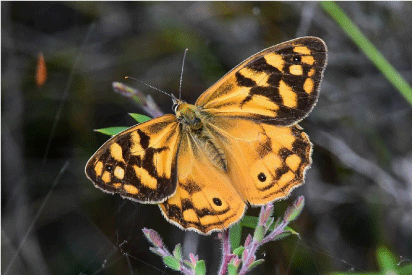
Lower was elected a member of the Royal Society of South Australia in 1888 and published the first of many papers in their Proceedings four years later. Early in his career he was entrusted with reporting upon the Lepidoptera collected by Richard Helms, the naturalist on the Elder Scientific Exploration Expedition, 1891–2.84 Similarly, Professor Baldwin Spencer (1860–1929), zoologist on the Horn Scientific Expedition to the MacDonnell Ranges and surrounding area of Central Australia, conveyed the Lepidoptera to Lower for comment. In a short report he noted that most of the species collected were widespread species familiar in the south and described only a single new species.85
Lower’s long association with Broken Hill was certainly one key to his scientific achievements. No other collector of his era enjoyed as extended and ready access to the inland insect fauna as Lower. A contemporary, Walter W. Froggatt (1858–1937) the New South Wales government entomologist, was also a pioneer investigator of the insects of the arid and semi-arid zone around the turn of the twentieth century, but concentrated mainly on Homoptera, Neuroptera and termites as well as farm and forestry pests. Froggatt consulted Lower on moth identifications and also adopted his arrangement of Lepidoptera families in a famous textbook.86
An enduring insight was Lower’s discovery that the moth fauna of the semi-arid woodlands, especially mulga and mallee, was rich in well-adapted moths, often in clades with likely sister groups in the more mesic forests and woodlands nearer the coast. These adaptations include strategies to survive the hot dry summers such as pupating below ground and emerging as moths in the cooler autumn. Good examples are the Acacia-feeding genera Thalaina (Fig. 11) and Chlenias, and there is much future work to be done in revealing and interpreting these patterns in other taxa.
Satin Moth Thalaina tetraclada (Lower, 1900)—first discovered at Broken Hill. A member of an Acacia-feeding clade involving a dozen attractive moths across southern Australia, half of which occur in the semi-arid zone. [♂ Wirraminna SA, 21.iv.2021]. Photograph courtesy of Peter Koch.
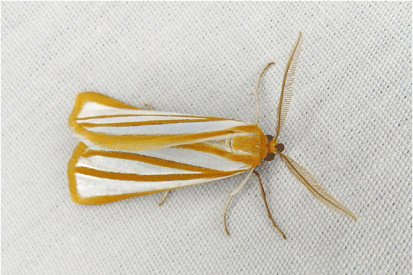
It is a measure of his reputation that Lower co-authored two significant papers, both on rather difficult families, with Edward Meyrick, arguably the pre-eminent lepidopterist of his generation.87 A high school classics master, Meyrick collected in several Australian colonies in the late 1870s and early 1880s before returning in 1886 to live and teach in England, but maintained a close interest in Australian Lepidoptera. Their joint paper on the Australian bagworm moths (Psychidae), regarded by them as ‘the most curious and remarkable of all Australian Lepidoptera’ remains a significant study on this important family.88 A century later, Ted Edwards and others observe that the extensive review of the skipper butterflies of Australia by Meyrick and Lower in 1902 ‘was a valiant attempt to sort out the considerable confusion existing with the Hesperiidae’.89 This review set the stage for a later paper that was more successful.’90 With some guidance from other experts, Lower made a second attempt to clarify the Hesperiidae in 1911, entitled ‘Revision of the Australian Hesperiadae’.91 This paper was criticised for the long excerpts from previous papers, among other things,92 it did make a great deal of progress and certainly helped later authors to bring order to the Hesperiidae’.93
The O. B. Lower collection at the South Australian Museum contains many rare species including numerous examples discovered by Lower himself (for example, Niceteria macrocosma Lower, Fig. 12). His specimens of an eriocottid moth Eucryptogona trichobathra Lower from Broken Hill, taken in the late autumn of 1898,94 are among the only individuals of this rare and primitive moth family ever collected in Australia.95 Eriocottid moths have recently been discovered in the fossil record in Europe and the family is possibly Gondwanan in origin.96 Similarly, the rarely seen pyraloid moth Hednotodes callichroa Lower from the mallee is one of the few known members of the subfamily Chrysauginae in Australia (Fig. 13).
The Showy Geometrid Niceteria macrocosma (Lower, 1899)—a striking moth from tall Eucalyptus forest in eastern Australia. The type specimen was found impaled on the leaf tip of a grasstree near Bacchus Marsh by Mr C.C. Brittlebank a local naturalist (Hewish 2006). [♂ Gippsland Vic]. Photograph courtesy of Ben Cruachan.
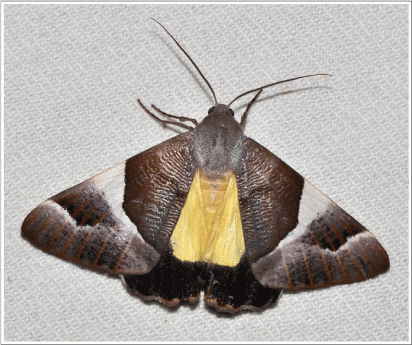
The rarely seen pyraloid moth Hednotodes callichroa Lower from the mallee is one of the few known members of the subfamily Chrysauginae in Australia. [♂ 30 km E by N of Swan Reach SA 30.i.2023]. Photo courtesy of Mark Hura.
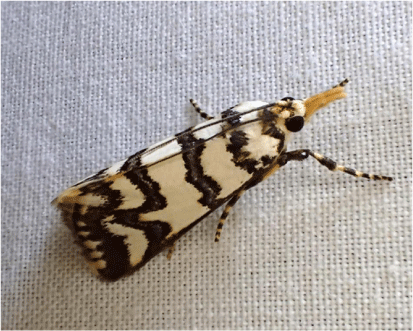
Lower also described several Lepidoptera that are now well known as important agricultural or horticultural pests, although their significance was not apparent at the time. The macadamia nutborer Cryptophlebia ombrodelta Lower (Fig. 14) is a widespread and serious pest of tropical and subtropical fruit and ornamental trees.97 The sugarcane armyworm Leucania stenographa Lower (Fig. 15), widespread from Europe to the south-west Pacific, was described from specimens he collected at Parkside.98 One of the few known butterfly pests, the yellow palm-dart Cephrenes trichopepla (Lower) (Fig. 16), has spread extensively from its tropical native range to infest ornamental palms in Perth and Alice Springs,99 and has recently invaded Singapore and Sri Lanka where it is a pest of coconut palms.100
The Macadamia Nutborer Cryptophlebia ombrodelta (Lower, 1898)—a widespread pest on a range of tropical fruits in Australia and eastern Asia. [♂ Imbil Qld, iv.2018] Photograph courtesy of Ian McMillan.
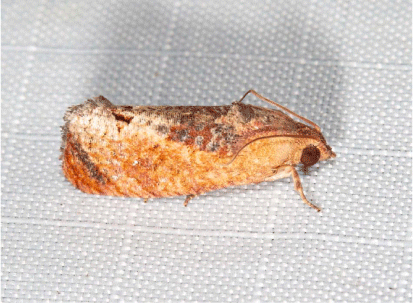
The Sugarcane Armyworm Leucania stenographa Lower, 1900 was described from a specimen collected at Parkside, but is now known to be widespread in the south-west Pacific region. [♂ Ducklo Qld, 6.viii.202] Photograph courtesy of Rog Standen.
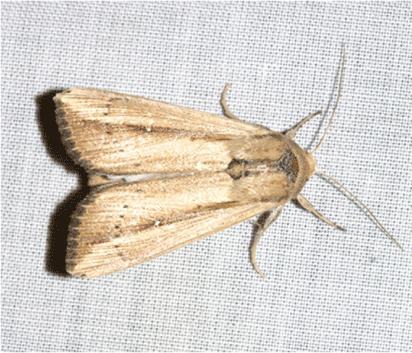
The Yellow Palmdart, Cephrenes trichopepla (Lower, 1908) is one of the few butterfly species which is a horticultural pest. [♂ Sri Lanka] Photograph courtesy of George van der Poorten.
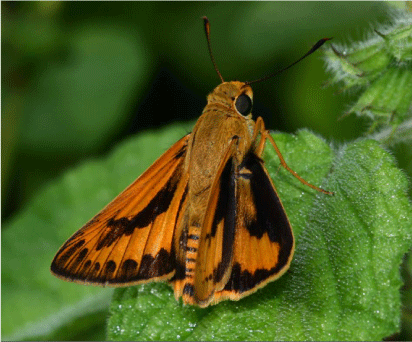
Lower was a dedicated cataloguer of Lepidoptera, producing foundation studies of historical importance. He published an early catalogue of the butterflies of South Australia,101 and assembled the first checklist of the moths of Victoria, published in 26 parts in the Victorian Naturalist between 1893 and 1897.102 During the Great War, he published the first regional checklist of butterflies and moths from the Australian outback (in four parts) and was able to show that the semi-arid zone had a Lepidoptera fauna very different from the coast.103 Although mainly living in Adelaide by that time, he could draw deeply on his extensive collection and experience of 27 years spent in Broken Hill. The list was annotated with important ecological information such as the calendar months of flight activity for almost all species and comments on relative abundance and foodplant associations for others.
Lower discovered that a proportion of the Lepidoptera of the inland timed their lifecycles so that their adult stage coincided with the cooler parts of the year, with a spike in flight activity following the autumn rains, a behaviour now recognised across many desert invertebrates.104 Larvae were found to be abundant in the wetter part of the year, coinciding with new plant growth. From field collections, Lower reared a number of species from their larval stages for the first time and was interested in the association of Lepidoptera with their foodplants and habitat. The geometrid moth ‘Diastictis’ goniota Lower was reared from Muehlenbeckia vines at Hallett’s Cove near Adelaide, subsequently confirmed by Noel McFarland who reared about ten of Lower’s species from southern Australia.105 A short biogeographical essay on the widespread hawkmoth Hyles livornicoides speculates on the important role of a well-developed dispersal ability in the arid zone fauna that is now known to be a common feature of the regional Lepidoptera.106
In his review of the substantial contribution of non-professional entomologists in Australia, Ian Mackerras (1898–1980) defines the years 1891–1927 as the ‘Period of the amateurs’,107 an era which almost exactly spans the 31-year spread of Lower’s publications.
A physical legacy
The Oswald Lower collection of Lepidoptera, some 40 000 specimens, preserved at the South Australian Museum represents a major legacy to present and future of Australian science. In particular, his material from the Adelaide Plains is a precious archive of a local fauna now largely lost. Until a century ago, the coastal strip of the plains retained a distinctive suite of vegetation communities along a floodplain, noteworthy among which was the extensive sedgelands and heaths known as the Reedbeds,108 now consumed by development. Nearby coastal suburbs such as Semaphore, Largs Bay and Exeter feature as type localities for various Lower species, some of which have not been observed since. The beautiful geometrid Notiosterrha rhodocosma (Fig. 3) is an example. A century later, the botanist Darrell Kraehenbuehl described the original and remnant vegetation of the Adelaide area but also chronicled the dramatic decline of the local flora since Lower’s time.109
Lower’s extensive Broken Hill material is similarly of outstanding scientific importance since it represents a baseline sample of the local moth fauna extant before the worst of the environmental degradation of western New South Wales which followed pastoralism in the late nineteenth century.110 His arrival there in the late 1880s coincided with the first invasion of rabbits into this part of the interior but antedated the peak in sheep numbers. In the following decades the landscape around the Barrier Ranges was progressively devastated through over-grazing by sheep, rabbits and goats, and trees and shrubs were removed for fuel such that severe sheet erosion was reported by 1908.111 Drifting sand and regular dust storms made life difficult in Broken Hill well into the twentieth century.112
In recent years, a sustained search for Lower’s original type specimens has been made in order to help clarify the nomenclature of the Australian Lepidoptera.113 To this end, a collection of KODACHROME images of these important specimens has been archived at the Australian National Insect Collection in Canberra. The subject specimens bear a special label attached to their pin linking an identifying code to the image (Fig. 9). Lectotypes (a specimen selected from a group of candidates and designated as the name-bearing type some time after the original description was published) from his collection have been progressively chosen for some species as modern revisions on various taxa progress.114
As biodiversity studies encourage a new focus on fauna conservation and habitat restoration, the pioneering work of Oswald Lower will continue to grow in importance. The capacity of wildlife managers to plan for the conservation of the biota depends in no small measure on the correct identification and habitat needs of the species involved.
A full bibliography of Lower’s scientific papers is presented elsewhere and is not repeated here,115 while the most recent nomenclatural arrangement of almost all his species names is available in the Checklist of the Lepidoptera of Australia.116
Acknowledgements
The authors thank the following people for helpful information and comments: Ms Denise Schumann, Cultural Heritage Advisor for the City of Norwood, Payneham and St Peters; Mr H. Lower of Adelaide, a great great nephew of Oswald, and family historian Ms Bonnie Coventry of Adelaide. Rev. Susan Straub, former parish priest at St Thomas Anglican Church, Port Lincoln provided information on Thomas Blackburn. Access to the Lower Collection at the South Australian Museum was facilitated by Ms Jan Forrest who also offered insights into the remedial re-pinning of the insect collection undertaken in the 1970s. Denis Binnion kindly allowed the use of his photo of the Pirie Building at Broken Hill.
References
Atkins, A. (1978) The Hesperilla malindeva group from northern Australia, including a new species (Lepidoptera: Hesperiidae), Australian Journal of Entomology, 17, 205-215.
| Crossref | Google Scholar |
Austin, A. D., and Burnyoczky, V. (1990) Catalogue of invertebrate type specimens held in the collections of the Waite Agricultural Research Institute and the South Australian Department of Agriculture, Transactions of the Royal Society of South Australia, 114, 47-53.
| Google Scholar |
Braby, M. F., and Beaver, E. P. (2022) The nomenclature and type status of Telicota paceka mesoptis Lower, 1911 (Lepidoptera: Hesperiidae), Records of the Australian Museum, 74(3), 99-102.
| Crossref | Google Scholar |
Carter, H. J. (1927) Presidential address, Proceedings of the Linnean Society of New South Wales, 51, ii-v.
| Google Scholar |
Coleman, D. (2021) George Lyell and Frederick Parkhurst Dodd: authority and expertise in nineteenth-century Australian entomology, Memoirs of Museum Victoria, 80, 169-181.
| Crossref | Google Scholar |
Croft, J. and Willey, K. (1986) ‘Lower, Leonard Waldemere (Lennie) (1903–1947)’, in Australian Dictionary of Biography, eds Nairn, B. and Serle, G. Australian National University, Canberra. https://adb.anu.edu.au/biography/lower-leonard-waldemere-lennie-7251/text12561
Edwards, E. D. (1992) A second sugarcane armyworm Leucania loreyi (Duponchel) from Australia and the identity of L. loreyimima Rungs (Lepidoptera: Noctuidae), Australian Journal of Entomology, 31, 105-108.
| Crossref | Google Scholar |
Edwards, E. D. (2010) The identity of Selidosema zygophora Lower, 1893 (Lepidoptera: Geometridae: Ennominae), Australian Entomologist, 37, 179-183.
| Google Scholar |
Goldfinch, G. M. (1944) Notes on Australian Boarmiidae and Oenochromidae (Lepidoptera) with descriptions of new species, Proceedings of the Linnean Society of New South Wales, 69, 189-197.
| Google Scholar |
Grund, R. (1998) South Australian butterflies and moths. Data Sheet: Yellow Palm-dart Cephrenes trichopepla (Lower), https://sabutterflies.org.au/hesp/trichopepla.html
Guest, E. (1887) A classified list of Geometrina found around Balhannah, with notes on species, Transactions of the Royal Society of South Australia, 9, 126-141.
| Google Scholar |
Hale, H. M. (1956) The first hundred years of the South Australian Museum 1856–1956, Records of the South Australian Museum, 12, 1-225.
| Google Scholar |
Hewish, M. (2006) Historical notes on Charles and Thomas Brittlebank, pioneer naturalists in the Werribee Gorge district, west of Melbourne, Victorian Naturalist, 123(5), 314-317.
| Google Scholar |
Hewish, M. (2014) Biographical notes on George Lyell, Victorian lepidopterist (Part 1), Victorian Entomologist, 44(5), 96-106.
| Google Scholar |
Jones, D. S. (2016) Evolution and significance of the regeneration reserve heritage landscape of Broken Hill: history, values and significance, Historic Environment, 28, 40-57.
| Google Scholar |
Kraehenbuehl, D. N. (1969) The life and works of J. G. O. Tepper, F.L.S., and his association with the field naturalists’ Section of the Royal Society of South Australia, South Australian Naturalist, 44(2), 23-42.
| Google Scholar |
Lea, A. M. (1912) The late Rev. Canon Thomas Blackburn B.A. and his entomological work, Transactions of the Royal Society of South Australia, 36, v-xl.
| Google Scholar |
Long, M. (2003) A biodiversity survey of the Adelaide Parklands, South Australia in 2003, Department for Environment and Heritage, Adelaide. https://data.environment.sa.gov.au/Content/Publications/Adelaide-Parklands-BioSurvey.pdf
Lower, O. B. (1892a) Descriptions of new South Australian Lepidoptera, Transactions of the Royal Society of South Australia, 15, 5-17.
| Google Scholar |
Lower, O. B. (1892b) Scientific results of elder exploring expedition. Lepidoptera, Transactions of the Royal Society of South Australia, 16, 10-15.
| Google Scholar |
Lower, O. B. (1893a) List of South Australian Rhopalocera, Transactions of the Royal Society of South Australia, 17, 1-12.
| Google Scholar |
Lower, O. B. (1893b) New Australian Lepidoptera, Transactions of the Royal Society of South Australia, 17, 146-185.
| Google Scholar |
Lower, O. B. (1893c) A catalogue of Victorian Heterocera. Part i, Victorian Naturalist, 10, 12-15.
| Google Scholar |
Lower, O. B. (1894) Remarks on South Australian Rhopalocera, Transactions of the Royal Society of South Australia, 18, 114-117.
| Google Scholar |
Lower, O. B. (1897) A catalogue of Victorian Heterocera. part xxiii–xxvi, Victorian Naturalist, 14, 13-16, 45–48, 77–80, 117–120.
| Google Scholar |
Lower, O. B. (1898) New Australian Lepidoptera: with a note on Deilephila livornica, Esp, Proceedings of the Linnean Society of New South Wales, 23, 42-55.
| Google Scholar |
Lower, O. B. (1900) Descriptions of new Australian Lepidoptera, Proceedings of the Linnean Society of New South Wales, 25(1), 29-51; 25(3), 404–423.
| Crossref | Google Scholar |
Lower, O. B. (1901) Descriptions of new genera and species of Australian Lepidoptera, Transactions of the Royal Society of South Australia, 25, 63-98.
| Google Scholar |
Lower, O. B. (1903) Descriptions of new Australian Noctuina, etc, Transactions of the Royal Society of South Australia, 27, 27-74.
| Google Scholar |
Lower, O. B. (1905) New Australian Lepidoptera. No. 22, Transactions of the Royal Society of South Australia, 29, 103-115.
| Google Scholar |
Lower, O. B. (1908) New Australian Lepidoptera – No. XXV, Transactions of the Royal Society of South Australia, 32, 110-120.
| Google Scholar |
Lower, O. B. (1911) Revision of the Australian Hesperiadae, Transactions of the Royal Society of South Australia, 35, 112-172.
| Google Scholar |
Lower, O. B. (1915) Descriptions of new Australian Lepidoptera, Proceedings of the Linnean Society of New South Wales, 40, 474-485.
| Crossref | Google Scholar |
Lower, O. B. (1916) Descriptions of new Australian Micro-lepidoptera, Transactions of the Royal Society of South Australia, 40, 537-544.
| Google Scholar |
Lower, O. B. (1918) The Lepidoptera of Broken Hill, New South Wales. Pt IV, Transactions of the Royal Society of South Australia, 42, 226-239.
| Google Scholar |
Lower, O. B. (1923) Descriptions of new Australian Lepidoptera, Transactions of the Royal Society of South Australia, 47, 54-57.
| Google Scholar |
Lunney, D. (2001) Causes of the extinction of native mammals of the Western Division of New South Wales: an ecological interpretation of the nineteenth century historical record, The Rangeland Journal, 23, 44-70.
| Crossref | Google Scholar |
Mackerras, I. M. (1949) Alfred Jefferis Turner and amateur entomology in Australia, Proceedings of the Royal Society of Queensland, 60(7), 69-87.
| Google Scholar |
Marks, E. N., and Mackerras, I. M. (1972) The evolution of a national entomological society in Australia, Australian Journal of Entomology, 11, 81-90.
| Crossref | Google Scholar |
McFarland, N. (1979) Annotated list of larval food plant records for 280 species of Australian moths, Journal of the Lepidopterist’s Society, 33(supplement), 1-72.
| Google Scholar |
Meyrick, E. (1878) Micro-Lepidoptera in Australia, Entomologist’s Monthly Magazine, 15, 70-72.
| Google Scholar |
Meyrick, E., and Lower, O. B. (1902) Revision of the Australian Hesperiadae, Transactions of the Royal Society of South Australia, 26, 38-129.
| Google Scholar |
Meyrick, E., and Lower, O. B. (1907) Revision of the Australian Psychidae, Transactions of the Royal Society of South Australia, 31, 192-208.
| Google Scholar |
Monteith, G. B., and Mather, P. (1986) Single cells to spiny shells: Invertebrate Zoology, Memoirs of the Queensland Museum, 24, 173-197.
| Google Scholar |
Ngô-Muller, V., Engel, M. S., Nel, A., and Nel, J. (2020) First fossil Eriocottidae discovered in Eocene Baltic amber (Insecta: Lepidoptera), Zootaxa, 4834(2), 273-282.
| Crossref | Google Scholar |
Nielsen, E. S., and Robinson, G. S. (1991) The tineoid family Eriocottidae (Lepidoptera) in Australia, Australian Entomological Magazine, 17, 77-88.
| Google Scholar |
Robinson, G. S. (1986) Edward Meyrick: an unpublished essay on phylogeny, Journal of Natural History, 20, 359-367.
| Crossref | Google Scholar |
Sheil, P. (2003) Twang! That’s my sides splitting, Sydney Morning Herald, 20 September. http://www.smh.com.au/articles/2003/09/19/1063625193575.html?from=storyrhs
Tepper, J. G. O. (1893) Notes and remarks on South Australian Rhopalocera, Transactions of the Royal Society of South Australia, 17, 281-286.
| Google Scholar |
Tindale, N. B. (1955) Note on the eucosmid (olethreutid) moth Cryptophlebia ombrodelta (Lower), Transactions of the Royal Society of South Australia, 78, 97-98.
| Google Scholar |
Turner, A. J. (1894) Descriptions of Micro-Lepidoptera from Moreton Bay, Transactions of the Royal Society of South Australia, 18, 120-138.
| Google Scholar |
Turner, A. J. (1906) A note on the localities attributed to Australian Lepidoptera by Mr Oswald Lower, F.E.S, Transactions of the Royal Society of South Australia, 30, 194-198.
| Google Scholar |
University of South Australia (2003) ‘Teachers – Edward Guest’, http://www.unisanet.unisa.edu.au/research/condon/teachers/Teachers.asp?TeacherID=4647, accessed 5 February 2020.
van der Poorten, G., and van der Poorten, N. (2013) Cephrenes trichopepla (Lower, 1908): an invasive Australian species, recorded in Sri Lanka for the first time with notes on its biology, life history and distribution (Lepidoptera: Hesperiidae), Tijdschrift voor Entomologie, 156, 95-101.
| Crossref | Google Scholar |
Waterhouse, G. A., and Lyell, G. (1912) Descriptions of and notes on some Australian Hesperidae, Victorian Naturalist, 28, 223-228.
| Google Scholar |
Waterhouse, G. A. (1933) Notes on the type specimens of Hesperiidae (Lepidoptera) in the museums in Australia, with special reference to those in the South Australian Museum, Records of the South Australian Museum, 5, 49-62.
| Google Scholar |
Footnotes
1 Moyal (1986).
3 Froggatt (1907) p. 416.
7 See Encyclopedia of Australian Science and Innovation, https://www.eoas.info/index.html.
9 Anonymous (1884). From the Brisbane Courier, 2 May 1884: ‘Adelaide May 1: Samuel Lower, a musician, committed suicide to-day by cutting his throat with a razor. He had been drinking heavily lately.’ He was buried in an unmarked grave in West Terrace cemetery plot R4, 28, E, 23 (seen on 21 December 2009). Cemetery records death as 2 May 1884, age 49 years.
11 Anonymous (1885).
12 Lower (1884).
13 Anonymous (1909).
14 Anonymous (1926).
15 Lower (1893a).
16 Lower (1911) p. 130.
17 Lower (1900) p. 44.
18 Lower (1908) p. 119. His sister was Ida Edith Lower, born 1869 at Norwood, died 1928 at Wayville.
19 Lower (1893b) p. 181.
20 Anonymous (1928).
21 Lower (1916).
22 Lower (1897) p. 19.
23 Lower (1897) p. 52.
24 Lower (1897) p. 14.
25 Lower (1915).
27 Anonymous (1899).
29 Anonymous (1915) p. 2.
30 Anonymous (1895a) p. 1.
31 Anonymous (1894) p. 3.
34 Carter (1927).
35 McLennan (1998).
36 Anonymous (1914) p. 8.
38 Long (2003).
41 Lower (1893b) p. 151.
42 Lower (1893c).
44 Coleman (2021).
45 Lea (1912).
46 Lower (1892a).
47 Hewish (2014).
48 Lower (1894).
49 Lower (1905) p. 110.
50 Lower (1915).
51 Lower (1896) p. 164.
53 Anonymous (1906).
54 Lower (1923).
55 Goldfinch (1944).
56 Common (1983).
57 Guest (1887).
58 Common (1994).
59 Edwards (2010).
61 Goldfinch (1944) p. 194.
62 Lower (1900) p. 44.
63 For example Lower (1897) p. 16.
64 Lower (1903) p. 184.
65 For example Hampson (1903).
66 Lower (1911).
67 Turner (1894) p. 120.
68 Lower (1898) p. 54.
69 Morton (2022).
70 Lower (1892a) p. 10.
71 Anonymous (1927).
72 Hale (1956) p. 127.
73 For example, Meyrick (1921).
74 Turner (1906) p. 195.
76 Turner (1906).
77 Tindale (1955).
78 For example, Tindale (1955).
79 For example, Atkins (1978).
81 Meyrick (1878).
83 Moulds (1999).
84 Lower (1892b).
85 Lower (1896).
86 Froggatt (1907) p. 231.
87 Robinson (1986).
91 Lower (1911).
92 Waterhouse and Lyell (1912) p. 228.
94 Lower (1901).
98 Edwards (1992).
99 Grund (1998).
101 Lower (1893a).
102 Lower (1897).
103 Lower (1918).
106 Lower (1898).
107 Mackerras (1949).
109 Kraehenbuehl (1996).
110 Lunney (2001).
111 Jones (2016).
113 For example, Nielsen and others (1996).


